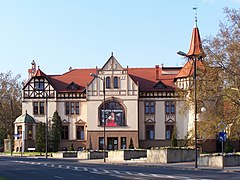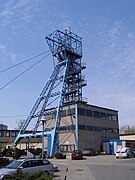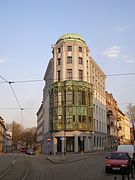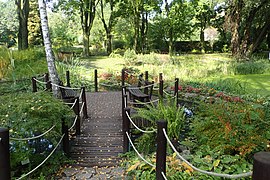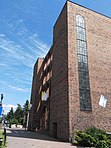Zabrze
Zabrze | ||
|---|---|---|
 Ulica Wolności (Liberty Street) | ||
|
Car plates SZ | | |
| Primary airport | Katowice Airport | |
| Highways | ||
| Website | https://www.um.zabrze.pl | |
Zabrze (Polish pronunciation:
Zabrze is located in the
History
Early history

| Year | Pop. | ±% |
|---|---|---|
| 1950 | 128,005 | — |
| 1960 | 188,800 | +47.5% |
| 1970 | 197,300 | +4.5% |
| 1980 | 196,000 | −0.7% |
| 1990 | 201,400 | +2.8% |
| 2000 | 197,111 | −2.1% |
| 2010 | 186,913 | −5.2% |
| 2020 | 170,924 | −8.6% |
| source [3] | ||
Biskupice, which is now a subdivision of Zabrze, was first mentioned in 1243 as Biscupici dicitur cirka
Early 20th century
In 1905, the Zabrze commune was formed by the former communes Alt-Zabrze, Klein-Zabrze and Dorotheendorf. The Zabrze commune was renamed Hindenburg in 1915 in honour of Generalfeldmarschall Paul von Hindenburg. The name change was approved by Emperor Wilhelm II on 21 February 1915.[7] Up until then, it was one of the few cities whose Polish name was retained during German rule.
In 1904 the
Interwar period

During the plebiscite held after
In the 1920s, the
The anti-Polish organization Bund Deutscher Osten was very active in the city, it dealt with propaganda, indoctrination and espionage of the Polish community, as well as denouncing Poles to local authorities.[18] When, the Barbórka (traditional holiday of miners) church services were organized separately for Poles and Germans in 1936, the Polish service enjoyed a greater attendance,[19] however, due to Nazi oppression and propaganda, the attendance at Polish services in the 1930s gradually decreased, according to Bund Deutscher Osten.[20] Polish activists were increasingly persecuted since 1937.[10] People were urged to Germanise their names, Polish inscriptions were removed from tombstones.[18] Some Polish priests were expelled from the city, both before[21] and during World War II.[22] As a result of German persecution the Jewish community dropped from 1,154 people in 1933 to 551 in 1939, and its remainder was deported to concentration camps in 1942.[14] The town's synagogue, that had stood since 1872, was destroyed in the Kristallnacht pogroms of November 1938.[23]
World War Two
During World War II, in 1941 the German administration requisitioned church property, in which it removed Polish symbols and memorabilia.
In January 1945, the Soviets captured the city and afterwards deported some inhabitants to the
Contemporary history

Following World War II, according to the Potsdam Agreement the city was handed over to Poland in 1945 and the town's name was changed to the historic Zabrze on 19 May 1945. The first post-war mayor of Zabrze was Paweł Dubiel, pre-war Polish activist and journalist in Upper Silesia, prisoner of the Dachau and Mauthausen concentration camps during the war.[27] The pre-war Polish inhabitants of the region were joined by Poles expelled from former eastern Poland annexed by the Soviet Union (from Kresy). Moreover, Polish settlers from the central part of Poland also settled in Zabrze.
The city limits were largely expanded in 1951, by including Mikulczyce, Rokitnica, Grzybowice, Makoszowy, Kończyce and Pawłów as new districts.[28] New neighbourhoods were built from the 1950s to 1990s.[28] In 1948, Górnik Zabrze football club was founded, which won its first Polish championship in 1957, and soon became the pride of the city as one of the most successful clubs in Poland.
Administrative division

On 17 September 2012, the Zabrze city council decided on a new administrative division of the city. Zabrze was subsequently divided into 15 districts and 3 housing estates.[29]
- 1. Helenka
- 2. Grzybowice
- 3. Rokitnica
- 4. Mikulczyce
- 5. Młody Górnik estate
- 6. Mikołaj Kopernik estate
- 7. Biskupice
- 8. Maciejów
- 9. Tadeusz Kotarbiński estate
- 10. Centrum Północ
- 11. Centrum Południe
- 12. Guido
- 13. Zaborze Północ
- 14. Zaborze Południe
- 15. Pawłów
- 16. Kończyce
- 17. Makoszowy
- 18. Zandka
Infrastructure
The Polish north–south A1 and east–west A4 motorways, which are parts of the European routes E75 and E40, respectively, run through Zabrze, and their junction is located just outside the city limits. In addition the Polish National roads 78, 88 and 94 also run through the city. The
Culture and sights
Among the cultural institutions of the town are the
Among the historical architecture there are many industrial facilities, as well as various churches, houses, public buildings, etc. Important monuments of architecture were built the
There is also a botanical garden and several parks in Zabrze.
-
Coal Mining Museum
-
New Theatre
-
Main post office
-
Regional Court in Zabrze
-
Maciej mine shaft
-
Guido mine shaft
-
Main Key Adit
-
Admiralspalast Hotel
-
Housing estate on Słowiański Square
-
St Joseph's Church
-
Botanical garden
Politics

Members of Parliament (Sejm) elected from Bytom/Gliwice/Zabrze constituency
- Chojnacki Jan, SLD-UP
- Dulias Stanisław, Samoobrona
- Gałażewski Andrzej, PO
- Janik Ewa, SLD-UP
- Kubica Józef, SLD-UP
- Martyniuk Wacław, SLD-UP
- Okoński Wiesław, SLD-UP
- Szarama Wojciech, PiS
- Szumilas Krystyna, PO
- Widuch Marek, SLD-UP
Sports
The city's most renown sports team is
Many sportspeople were born in Zabrze, including footballers Jerzy Gorgoń, Łukasz Skorupski and Adam Bodzek, and pro ice hockey player of the National Hockey League, Wojtek Wolski.
Economy
Like other towns in this populous region, it is an important manufacturing centre, having
Notable people



- James Kleist (1873–1949), German-American Jesuit scholar
- Heinz Fiebig (1897–1964), Wehrmacht general
- Jerzy Gorgoń (born 1949), Polish former football player
- Fritz Katz (1898–1969), pioneer of adrenal transplants
- Waffen SS
- Władysław Turowicz (1908–1980), Polish-Pakistani military scientist
- Fritz Laband (1925–1982), German footballer
- Werner Heiduczek (1926–2019), German author
- Friedrich Nowottny (born 1929), German television journalist
- Janosch (born 1931), German author
- Joachim Kroll (1933–1991), German serial killer
- Joachim Kerzel (born 1941), German actor
- Jan Sawka (1946–2012), Polish-American artist, architect
- Krystian Zimerman (born 1956), Polish classical pianist
- Waldemar Sorychta (born 1967), Polish heavy metal musician and producer
- Sebastian Kawa (born 1972), Polish glider pilot, sixteen-time World Champion
- Czesław Śpiewa, (born 1979), Polish singer
- Wojtek Wolski (born 1986), Polish-Canadian ice-hockey player.
- Margarete Stokowski (born 1986), Polish-German writer
- Bartosz Bednorz (born 1994), Polish volleyball player
Twin towns – sister cities
References
- ^ a b "Local Data Bank". Statistics Poland. Retrieved 24 July 2022. Data for territorial unit 2478000.
- European Spatial Planning Observation Network (ESPON) [1] Archived 28 July 2009 at the Wayback Machine
- ^ "Zabrze (śląskie) » mapy, nieruchomości, GUS, noclegi, szkoły, regon, atrakcje, kody pocztowe, wypadki drogowe, bezrobocie, wynagrodzenie, zarobki, tabele, edukacja, demografia".
- ^ a b Agata Mucha. "Zespół zabudowy dawnej Kopalni "Królowa Luiza"". Zabytek.pl (in Polish). Retrieved 25 July 2021.
- ^ a b Michał Bugaj. "Grodzisko stożkowate (Mikulczyce)". Zabytek.pl (in Polish). Retrieved 25 July 2021.
- ^ Michał Bugaj. "Grodzisko stożkowate (Rokitnica)". Zabytek.pl (in Polish). Retrieved 25 July 2021.
- ^ a b c d Historia – Hindenburg Archived 1 May 2019 at the Wayback Machine at the official website of Zabrze
- ^ a b c "Polskie Towarzystwo Gimnastyczne "Sokół" w Zabrzu, Historia Zabrza". 31 July 2016. Retrieved 10 June 2019.
- ^ Encyklopedia powstań śląskich, Instytut Śląski w Opolu, Opole, 1982, p. 637
- ^ a b Cygański 1984, p. 24.
- ^ a b Rosenbaum & Węcki 2010, p. 74.
- ^ Rosenbaum & Węcki 2010, p. 124.
- ^ Rosenbaum & Węcki 2010, p. 60.
- ^ a b Rosenbaum & Węcki 2010, p. 35.
- ^ Rosenbaum & Węcki 2010, p. 53-54.
- ^ Zalega, Dariusz (2024). Chachary. Ludowa historia Górnego Śląska (in Polish). Warszawa. p. 201.
{{cite book}}: CS1 maint: location missing publisher (link) - ^ Stadtkreis Zabrze Archived 3 March 2016 at the Wayback Machine at Geschichte on Demand website
- ^ a b Rosenbaum & Węcki 2010, p. 50.
- ^ Rosenbaum & Węcki 2010, p. 130.
- ^ Rosenbaum & Węcki 2010, p. 157.
- ^ Cygański 1984, p. 26.
- ^ Rosenbaum & Węcki 2010, p. 100.
- ^ Ghetto Fighters' House archives, Photo No. 55805: a memorial monument placed by the Zabrze municipality in 1998 to commemorate its Jewish community.
- ^ Rosenbaum & Węcki 2010, p. 102.
- ^ Rosenbaum & Węcki 2010, p. 105.
- ^ a b "Working Parties". Stalag VIIIB 344 Lamsdorf. Archived from the original on 29 October 2020. Retrieved 25 March 2020.
- ^ "Dubiel Paweł Mikołaj (1902–1980)". Biblioteka Sejmowa (in Polish). Retrieved 25 March 2020.
- ^ a b "Okres powojenny". Urząd Miasta Zabrze (in Polish). Archived from the original on 1 May 2019. Retrieved 25 March 2020.
- ^ Zestawienie liczby mieszkańców z uwzględnieniem podziału na dzielnice na dzień: 30-09-2013[permanent dead link].
- ^ Rozporządzenie Prezydenta Rzeczypospolitej Polskiej z dnia 14 lipca 2020 r. w sprawie uznania za pomnik historii "Zabrze - zespół zabytkowych kopalni węgla kamiennego", Dz. U. z 2020 r. poz. 1288
- ^ "Miasta partnerskie i zaprzyjaźnione". um.zabrze.pl (in Polish). Zabrze. Archived from the original on 21 September 2019. Retrieved 11 March 2020.
Bibliography
- Cygański, Mirosław (1984). "Hitlerowskie prześladowania przywódców i aktywu Związków Polaków w Niemczech w latach 1939 – 1945". Przegląd Zachodni (in Polish) (4).
- Rosenbaum, Sebastian; Węcki, Mirosław (2010). Nadzorować, interweniować, karać. Nazistowski obóz władzy wobec Kościoła katolickiego w Zabrzu (1934–1944). Wybór dokumentów (in Polish). ISBN 978-83-8098-299-4.
External links
- Municipal website (in Polish)
- Zabrze Community (in Polish)
- Portal Zabrze.com.pl (in Polish)
- Encyclopædia Britannica Zabrze
- Jewish Community in Zabrze on Virtual Shtetl


